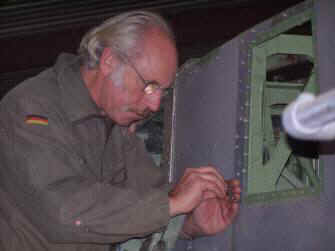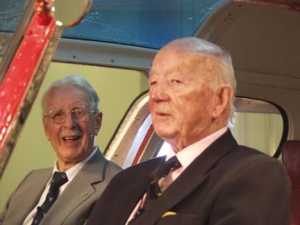Restoration of Bristol 192 Belvedere HC1, XG452
Bristol Belvedere History |
||||
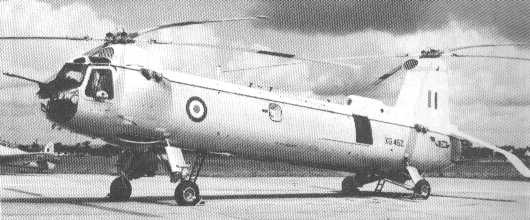 |
This twin-rotor Bristol 192 Belvedere HC1, XG452, c/n 13347, a medium lift transport, was powered by two Napier Gazelle 100 turbo-shafts, each of 1650 shp. It first flew early in 1960 and was the fifth and final prototype. The first example had flown in 1957. | |||
| Throughout its active life XG452 was used for flight control testing and for engine development trials. XG452 was involved in lengthy evaluation, by A & AEE, at Boscombe Down in the UK and later in France. In June 1960 it set up a new average speed record of 209km/hr (130 miles/hr) for a flight between Gatwick, in England, and Luqa, in Malta, while en route to Idris, in Libya, for its tropical trials. A single overload fuel tank was fitted for the outward ferrying flight. The longest stage was 475 nautical miles. The Idris trials included performance, handling, engineering and radio tests. | ||||
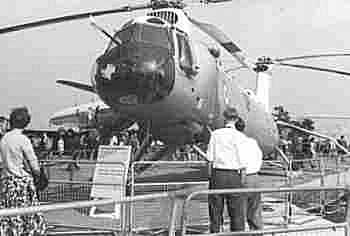 |
On 26th August
1960, XG452 returned to Boscombe Down, after a stopover in Le Bourget
du Lac for high altitude trials over the French Alps. Meanwhile,
in April 1960, the helicopter interests of the Bristol Aeroplane
Co. had been sold to Westland Aircraft, who also took over Saunders-Roe
and Fairey Aviation. Belvedere HC1, XG452, appeared (left) in the SBAC static display at Farnborough in 1960, with two other Belvederes, XG451 & XG454, three months after its record breaking flight to Malta and Libya. Just visible in the photo is a RAF De Havilland Comet 2, XN453, then in service with the Royal Aircraft Establishment. The first Belvedere to be shown at a Farnborough show was XG447, the first prototype, in 1958. |
|||
| 26 Belvederes were built and completed in Weston-super-Mare, home of The Helicopter Museum in the south-west of England, following a long and involved development programme. The first three pre-production machines were delivered to the RAF, in October 1960, with wooden rotor blades which were replaced, later, by metal blades. | ||
 |
The first operational squadron, No.66, was formed from the Belvedere Trials Unit and was based at RAF Odiham, in Hampshire, equipped with six Belvederes and forming part of RAF Transport Command. Most of the twenty-six machines delivered, served with No.26, No.66 and No.72 Squadrons of the RAF, as Support Helicopters, in Borneo, Aden, Tanganyika, Malaya, Libya, and the UK, between 1961 and 1969. | |
| In June 1962, XG465, a Belvedere of No.72 Squadron, the second squadron to be formed and based at Odiham, attracted much publicity when, piloted by Squadron-Leader John Dowling, it lowered a spire to complete the rebuilding of the new Coventry Cathedral. In the severe winter of early 1963, No.72 Squadron supplied Belvederes for mercy flights in the snow-bound UK. The last Belvederes were withdrawn from service in March 1969 when No.66 Squadron disbanded at Seletar, Singapore, after service in Borneo and Malaysia. It was to be over ten years before the RAF acquired another twin-rotor transport helicopter, the Boeing Chinook, which had a vastly improved performance. | ||
| Following earlier evaluation, XG452 was used for a prolonged series of trials, including a second trip to Libya in 1964 for troop movement trials, before being returned to Weston-super-Mare in 1966 to be prepared for operational use by the RAF. However it never entered active service and, in 1967, was transported to RAF Cosford where it remained until 1971, in use as a ground instruction airframe with No.2 School of Technical Training. Then, after three years at RAF Ternhill, initially in use for rescue and crash training, it was abandoned. It became derelict and was purchased by The Helicopter Museum, in 1974, but not moved to Weston-super-Mare until November 1975. |  |
|
| XG452 at RAF Ternhill in 1974 | ||
| Soon after the Belvedere's arrival, in Weston, a volunteer Preservation Group was formed, mainly from local Westland Helicopter employees who were able to obtain and install most of the major exterior components found to be missing from XG452. Some of the components were recovered from Singapore where XG448 had been used as an instructional airframe, at RAF Changi, from the late sixties. These early efforts, based in Westland company premises, allowed the machine to be refurbished, exhibited at several local events, including the Avon Air Days, and the fuselage made relatively weatherproof, vital at a time when the Museum could not yet provide adequate shelter from the elements. The restoration was halted in 1978, due to the lack of a weatherproof working area after the machine was moved from the Westland factory to outdoor storage at The Museum, but it supplied a springboard for the later restoration which started in 2001. | ||
Bristol Belvedere XG452 Restoration |
||||
 |
The Bristol 192 Belvedere, XG452, was wheeled out of the new Display Hangar on August 25th 2001, allowing work to re-start. The rotor blades and large anhedral tailplane had been removed previously. As long as good weather and light allowed, work proceeded in the open air (L & R) but, in late October 2001, it was moved into the Restoration Hangar. | 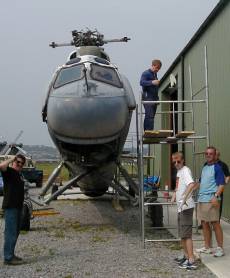 |
||
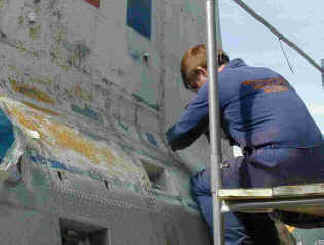 |
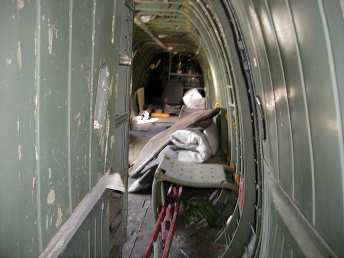 |
| On September 1st 2001 Rod Holloway (above left) started to remove bolts which secured one of the panels which give access to the rear rotor drive shaft of the Belvedere. This proved to be a long and difficult job because of the corrosion to the nuts and bolts which has taken place and the need to avoid damage to the panel itself. Meanwhile work started to clear wanted and unwanted items from the cabin interior (above right). | |
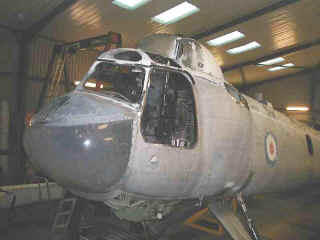 |
XG452 (left) on 1st December 2001 in the Restoration Hangar. All doors, seats and windows had been removed and the process of stripping out the cockpit fittings was well under way. Quite a lot of severe corrosion was found in the cockpit area but the main structure was all in good condition. | |
| Jim Harvey and Tony Owens started to partially dismantle Belvedere XG452's forward rotorhead (right) on 24th November 2001. The Museum has a spare forward rotorhead so the best components from each were to be used in the final reassembly. | 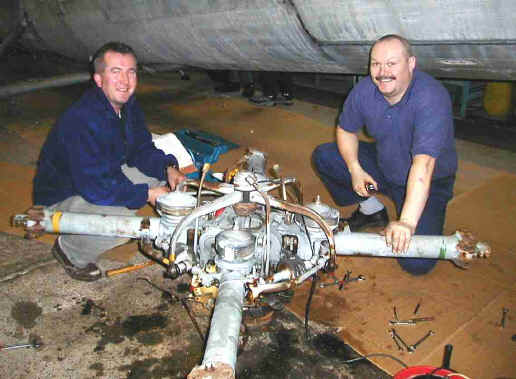 |
|
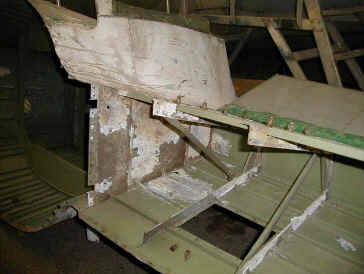 |
Looking inside
the vertical fin and fixed rudder assembly (left) of XG452 on 11th September
2002, with large patches of corrosion
awaiting attention. The search for corrosion and the application of suitable treatment, varying from cleaning to total replacement of structural components, have occupied much of the team's time throughout the restoration to date. A few components have been manufactured on site, when the originals could not be repaired or replaced. For example, the rails for the runners on XG452's sliding door were severely corroded, probably because of trapped moisture. In Spring 2004, Rod Holloway manufactured new rails and these were fitted a few weeks later. Later on the door itself was completely refurbished. |
|
| XG452 in the Restoration Hangar (right) in August 2002. The Museum had acquired some excellent staging, which Westland no longer needed due to the impending closure of their Weston-super-Mare plant in September 2002. | 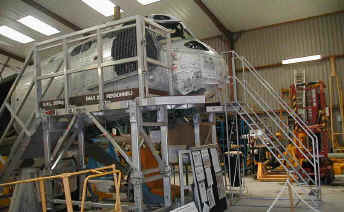 |
|
 |
The drive/synchronisation shaft, for the
rotors, and all the control rods, were removed from the duct which runs the length of the
top of the fuselage. These items were cleaned, cleared of corrosion and repainted, as was the duct itself. Similarly the lower duct (left), which carries hydraulic and fuel lines, was cleaned and refurbished. The RAF roundel, on the bottom of the fuselage, can be seen before paint stripping of that area |
|
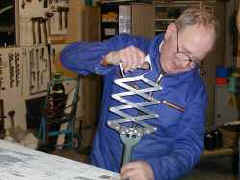 |
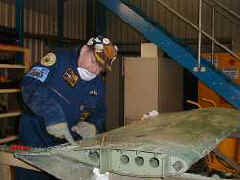 |
|
On 10th March 2004, Ben (
above left) replaced corroded rivets in one of the
outboard sections of XG452's compound anhedral tailplane (see
below) while Kevin (above right) cleaned several
layers of old paint and primer from an inboard section, to
allow treatment of patches of surface corrosion, before repainting. |
||
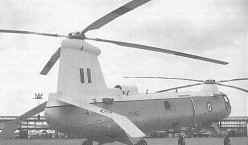 |
||
| Belvedere XG452 Tail Assembly | ||
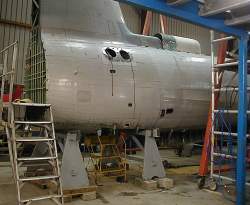 |
 |
|
In October 2005 XG452's rear
fuselage was hoisted to make it near horizontal. It was then
supported on trestles (above left) to allow all of the rear
undercarriage components (a few above right) to be removed,
the fuselage underside to be prepared for re-painting and
to give access to the rear engine compartment hatch. |
||
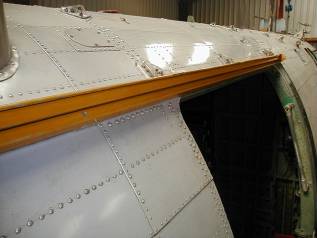 |
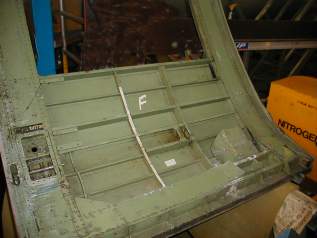 |
|
In
March 2004 Rod Holloway had manufactured new top rails for
the runner of XG452's sliding cabin door. The originals were
badly corroded. |
In
late 2005 work started on restoring the cabin door itself.
The door locking mechanism was corroded but the rest was in
good order. |
|
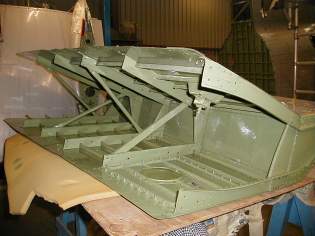 |
 |
||||||||||
In
October 2005 the inside of the fin and fixed rudder assembly
was carefully cleared of corrosion, then primed and painted. |
In
the rear engine compartment, in October 2005, looking up into
the rear pylon, it was seen that there was a little minor corrosion. |
||||||||||
 |
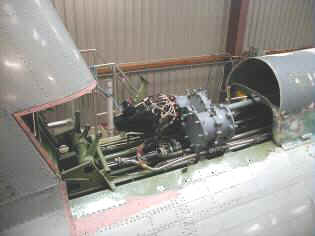 |
||||||||||
The
a.c. and d.c. generators were installed forward of the intermediate
gearbox, the fin and rear rotor pylon, in March 2006. |
The
enclosed oil cooler is mounted forward of the generators and
an auxiliary gearbox, but receives a straight-through drive. |
||||||||||
|
|||||||||||
Memories
One of the more enjoyable
aspects of working at The Helicopter Museum, is the occasional opportunity to listen to
visitors who tell us about their memories, or experiences, of the helicopters which are
being restored and exhibited. It almost brings the machinery to life.
Two of the early Bristol
Helicopters test-pilots, Charles "Sox" Hosegood and Peter Wilson, visited The
Museum on 3rd August 2004 to inspect restoration progress and to talk about the
development of the Sycamore and the Belvedere. "Sox" Hosegood was the first to
fly a Belvedere, XG447, in 1957 and displayed it at the Farnborough show in 1958. Peter
Wilson also played a major role in the development of the Sycamore before
moving on to test flying of the Bristol 173 and the Belvedere. |
|||||||||||||||||

